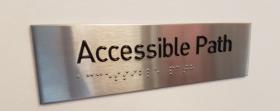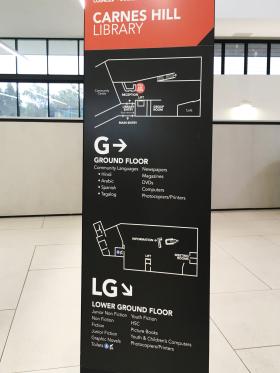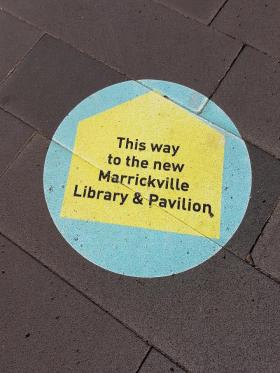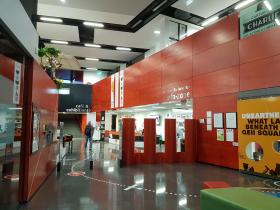Features and considerations: Accessibility and approach
A library must be open and accessible to the community. This means designing a building that promotes equity for people who are young and old, people with prams and people with disabilities.
Number of floors
A single-level library is preferable. A well-located lift is required in multi-level buildings.
Access and approach
The entry and all parts of the library should be barrier-free, without steps or obstacles, and designed in accordance with building codes and standards. This includes ramps, door widths, door furniture, aisle widths, lifts and toilets. Luminance contrast should be designed to assist people who are vision impaired with wayfinding.
Entry
The front door, the first point of contact with the library, must be highly visible, easy to find and easy to open for all users. Electronic sliding doors are preferable, but consideration for hardware and issues relating to ease of door use, such as weight, will inform alternate designs.
Car parking
Provide specially marked car parking spaces for people with disabilities close to the entry and in compliance with standards.
Mobility
Aisle widths and corridors must accommodate wheelchairs, prams and motorised scooters with enough space for turning.
See Australian Standard 1428.1.
Furniture and equipment
These should be comfortable – provide a range of alternatives and cater for people with a disability. Counter height at service desks, readers’ desks, catalogue systems and carrels must cater for wheelchair users and those in mobility scooters, with height adjustable mechanisms for knee clearance.
Adaptive technology
Provide text to speech readers and scanning equipment that produce an audio file for people with vision impairment.
Reading magnifiers
These may also be appropriate for people with low vision.
Computer equipment
Trackball-type devices should be provided for people with physical hand impairments who cannot use a mouse.
Floor coverings
Provide non slip surfaces. All flooring materials must be tested using a range of methods including ramp and pendulum testing. Note that additional trip hazards can include floor mounted items such as in-floor lighting and grilles.
See Building Code of Australia as well as Australian Standards AS/NZS 4586 & 4663.
National Construction Code Volumes One and Two: Building Code of Australia
Carpet
If used, it should be low pile with firm underlay or direct stick. Carpet squares/tiles are recommended. Patterns on carpet should be considered carefully. People with dementia and other sensory issues may find patterned carpet challenging to navigate. Patterns and motifs may be seen as actual objects or holes in the floor that need to be avoided.

Communication
Provide clear external and internal signage, ideally with versions in Braille and raised tactile format. Provide tactile ground surface indicators for way finding, and hazard warnings and hearing loops in meeting rooms and where counter staff are behind glazed screens. Audio signage may be another consideration in some locations where appropriate to assist people who are blind or vision impaired.
Lighting
Lighting systems should provide diffuse even illumination that facilitates 400 Lux on counters and reading desks. Reading of book titles on the lower shelving requires a minimum 150 Lux at ground level within 300mm of books on shelves. Portable task light stands may also be appropriate for some people with low vision.
Shelving
Provide shelving at the appropriate height and reach for all users.
Standards
The Building Code of Australia and current Australian Standards will need to be followed in planning your building. These cover:
- accessible entry
- size of corridors
- bathroom amenities
- accessible car parking
- lift design, and
- additional requirements for accessible entry to retrofitted and refurbished buildings.
Bathroom amenities
Accessible toilets are required in public buildings. Consideration can be given to including features beyond those that are legislated. Some public recreational facilities provide adult change tables in their public toilets. This improves access for older children and adults with a disability and their carers. Larger bathroom cubicles may be useful for those who need assistance using public toilets.
All gender toilet facilities are also provided in some libraries. The doors can include the label ‘all gender’ and images of the facilities that are inside such as toilet, urinal and/or baby change.
Approachability
Public libraries are a ‘democratic space’, openly inviting use by all members of the community. How the library is perceived, and how easily it is used, is critical to its success and its impact on a community.
An approachable building has:
- considered building siting and design and how this influences the perception of a library by various members of a community
- transparent facades providing a direct relationship between the street or open space and the library interior. For those unfamiliar with libraries and what they offer, external transparency allows passers-by to see inside before entering.
- transparent work practices which make library environments less hierarchical by breaking down the boundaries between staff and users, e.g. smaller service desks, side by side consultation, roving librarians etc.
- transparent interiors with clear sightlines, both vertically and horizontally, that allow library users to navigate easily, e.g. low shelves, open staircases, high viewing points, voids between floors so that all levels can be seen
- comfortable and welcoming spaces which offer inviting settings for reading, study, research and recreation
- outlook – while introverted, cloister-like space still has its merits, views and outlook greatly enhance the library experience, strengthening a library’s connection with its greater context and creating quality space within
- access out of hours – allowing library users access to the library beyond traditional opening hours creates greater equity of access for the library community. This may relate to the use of some library spaces, such as meeting rooms or seating areas, the use of Wi-Fi outside, or use of parts of the library collection.
Wayfinding considerations
Clear circulation
Provide logical paths of movement that are apparent even without signage. This involves well located entrances, aisles, lifts, escalators, ramps etc.
Visual themes
Distinguish between different functional areas. This is achieved by providing staged experiences rather than maintaining a uniform internal atmosphere. In recent libraries, wayfinding has been aided by variations in colour, materials, lighting, furniture, scale, etc.
Signage
Make the library easy to navigate for all people. Recent trends include the use of graphics which breaks down language barriers, dynamic electronic signage, and signage seamlessly integrated with the design of the building and the brand of the library.



Accessible content
Given the ever increasing and diverse range of content now provided by libraries, library design should promote and enhance the navigation of this material. Critical to this is places to access the online catalogue and digital collections throughout the library.
Digital literacy
Libraries play a pivotal role in promoting digital literacy, ensuring equitable access for people who would not usually acquire digital skills. Building design implications may include ensuring that access to technology is pervasive (terminals spread and integrated into a range of library spaces) as well as spaces for training and collaborative working.